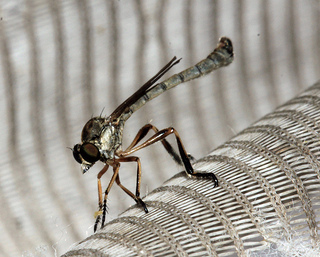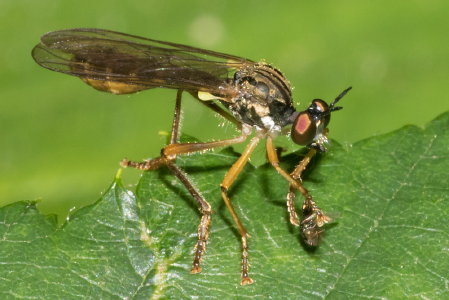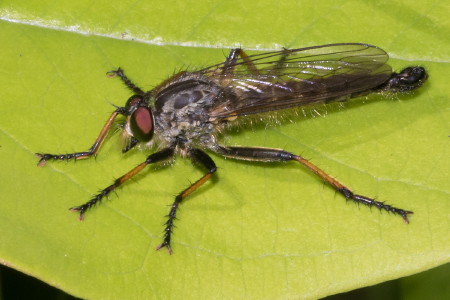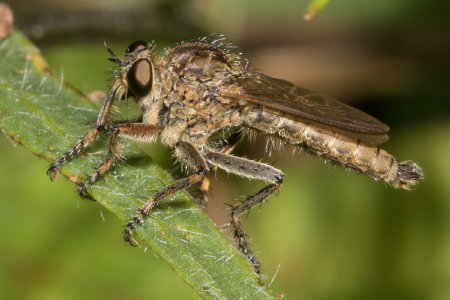Introduction
Robber flies are a large and diverse family of the Dipterian order that are
known for their predatory behavior. There are aprox 29 species occurring in
the UK. Diversity of Asilidaecan be attributed to their broad distribution;
most species have a tendency to occupy a selective niche. As thecommon name
implies, robber or assassin flies have voracious appetites and feed on a variety
of arthropods, which may help to maintain an insect population balance in
various habitats. Asilidae adults attack wasps, bees, dragonflies, grasshoppers,
other flies, and some spiders. Robber flies are abundant in arid / sunny habitats,
which are optimal conditions to observe their many morphs and behaviors.
Description
Asilidae are a family of true flies belonging to the superfamily Asiloidea
within the suborder Brachycera. To date, there are approximately 6,750 described
species of Asilidae distributed worldwide.
All robber flies have a characteristic divot on top of the head, dense moustache
of bristles on the face (mystax), which is located between their especially
prominent compound eyes. In general , adult Asilidae have a long body with
abdomen tapered . However, some species are stout and hairy, mimicking bumble
bees, and still others may be slender and have a damsel fly appearance. Adults
range in size from small (3 mm) to very large (over 50 mm), averaging 9 to
15 mm in length . Robber flies have long, strong legs that are bristled to
aid in prey capture. Sexual dimorphisms are not extreme, although females
tend to have slightly broader abdomens than males. Most robber flies have
a brown, gray, or black coloration
Robber flies, the Asilidae family, tend to have the vertex of the frons (the
area betweenthe eyes) sunken in, with the eyes raised above. Another characteristic
feature is a tuftof bristles between the antennae and the oral margin (the
edge of the cavity in the lowerpart of the head that contains the proboscis)
which is a called the mystax.The mystax assists in protecting the head and
face when the fly experiences defensive prey .
All robber flies have stout, spiny legs, aand 3 simple eyes (ocelli) in a
characteristic depression between their two large compound eyes. . The antennae
are short, 3-segmented, sometimes with a bristle-like structure called an
arista. The short, strong proboscis is used to stab and inject victims with
saliva containing neurotoxic and proteolytic enzymes which paralyze and digest
the insides; the fly then sucks the liquefied nutrients. et. A robber fly's
beak tip is covered with stiff bristles, designed to secure it within the
wound it creates the large, tapering, hard beak, contains a sharp lancet
Many species have long, tapering abdomens, sometimes with a sword-like ovipositor.
Others are fat-bodied bumble bee mimics; the effect is quite convincing.
Biology
Females deposit whitish-colored eggs on low-lying plants and grasses, or in
crevices within soil, bark, or wood. Egg-laying habits depend on the species
and their specific habitat; most species lay their eggs in masses, which are
then covered with a chalky protective coating.Many robber flies have specialised
ovipositors--the tubes through which the flies lay their eggs.Some of these
are designed for digging into soil or inserting between parts of plants. Robber
fly larvae live in the soil or in various other decaying organic materials
that occur in their environment. Larvae are also predacious, feeding on eggs,
larvae, or other soft-bodied insects. Robber flies overwinter as larvae and
pupate in the soil. Robber fly larvae live sub-teraneously and in decaying
wood where they prey upon the larvae of wood-boring beetles. In the ground
they may seek out and eat buried grasshopper eggs. Their pupae bristle with
spines possibly making an exit from underground or decaying logs a little
easier.Puparia migrate to the soil surface and emerge as adults, often leaving
behind their pupal casing. Complete development ranges from one to three years,
depending on species and environmental conditions.
The larvae of a Hyperechia spp (a robber fly, Asilidae) prey on the
larvae of the carpenter bee and it is thoughtthe resemblance of the adult
fly to the bee may enable the female robber fly to get near enough tothe bee
nest to lay her eggs.
Robber flies can be a pest of commercial apiarists , as they're commonly
known as bee-killers. The robber fly captures a bee by making rapid dashes,
catching it in flight, and squeezing it tightly against its own body with
its strong grasp. Immediately following this,a perching point is acquired.
POnly the dry shell of what was once a bee is left behind. With careful observation
robber fly feeding spots can be found. tell tale signs include bee hulls lying
on the ground.
Behavior
Robber flies are opportunistic predators of other insects,often catching them
on the wing, after which they take the insect to a roosting site and suck
out it's innards their diets often reflecting prey availability in a particular
habitat. Reports that of the nine Neotropical Asilidae species studied, diet
constituents were more than 85% composed of insects from the orders Diptera,
Coleoptera, Hymenoptera, Homoptera, and Lepidoptera. Furthermore, larger species
tended to consume a greater diversity of prey taxa. Robber flies generally
establish a perching zone in which to locate potential prey. Perching height
varies by species, but generally occurs in open, sunny locations. Asilidae
seize their prey in flight and inject their victims with saliva containing
neurotoxic and proteolytic enzymes. This injection, inflicted by their modified
mouthparts (hypotharynx), rapidly disable prey and digests bodily contents.
The robber fly soon has access to a liquid meal, which is generally consumed
upon returning to a perched position. The short, strong proboscis is used
to stab and inject victims with saliva containing neurotoxic and proteolytic
enzymes which paralyze and digest the insides; the fly then sucks the liquefied
meal Proboscis is uniquely adapted for stabbing and sucking
Robber flies have limitted or minimal courtship behavior, with male pouncing
on the female simply as if to catch prey. Copulation is in a tail-to-tail
fashion with the male and female genetalia interlocked. Flight is not completely
inhibited during mating.
Checklist of UK Recorded Asilidae
Family Asilidae
Subfamily Asilinae
Asilus crabroniformis - Hornet Robberfly Linnaeus, 1758
Dysmachus trigonus - Fan-bristled Robberfly Meigen,
1804
Eutolmus rufibarbis - Golden-tabbed robberfly Meigen, 1820
Machimus arthriticus - Breck robberfly Zeller, 1840
Machimus atricapillus - Kite-tailed robberfly
Fall? 1814)
Machimus cingulatus - Brown heath robberfly Fabricius, 1781
Machimus cowini - Manx Robber fly Hobby,
1946)
Machimus rusticus - Downland robberfly Meigen, 1820
Neoitamus cothurnatus - Scarce awl robberfly Meigen, 1820
Neoitamus cyanurus - Common awl robberfly Loew, 1849
Neomochtherus pallipes - Devon red-legged robberfly
Meigen, 1820
Pamponerus germanicus - Pied-winged Robberfly Linnaeus, 1758
Philonicus albiceps - Dune robberfly Meigen, 1820
Rhadiurgus variabilis - Northern robberfly Zetterstedt,1838
Subfamily Dasypogoninae
Leptarthus brevirostris - Slender-footed robberfly Meigen,
1804)
Leptarthus vitripennis - False slender-footed robberfly
Meigen, 1820)
Subfamily Laphriinae
Choerades gilvus - Ginger robberfly Linnaeus, 1758
Choerades marginatus - Golden-haired robberfly Linnaeus, 1758
Laphria flava - Bumblebee robberfly Linnaeus, 1761
Subfamily Leptogastrinae
Leptogaster cylindrica - Striped slender robberfly De
Geer, 1776
Leptogaster guttiventris - Dashed slender robberfly
Zetterstedt, 1842
Subfamily Stenopogoninae
Dioctria atricapilla - Violet black-legged robberfly
Meigen, 1804
Dioctria baumhaueri - Stripe-legged robberfly Meigen, 1820
Dioctria cothurnata - Scarce red-legged robberfly Meigen,
1820
Dioctria linearis - Small yellow-legged robberfly Fabricius,
1787
Dioctria oelandica - Orange-legged robberfly
Linnaeus, 1758
Dioctria rufipes - Common red-legged robberfly De Geer, 1776
Lasiopogon cinctus - Spring heath robberfly Fabricius, 1781
Link
Robber Flies


![]()
![]()
![]()
![]()
![]()

